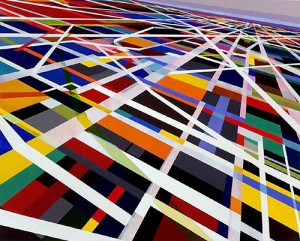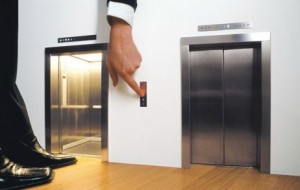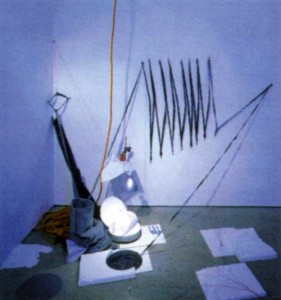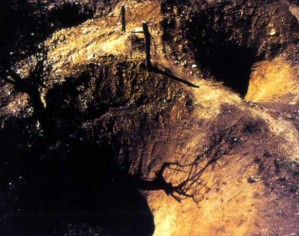For ‘ART AsiaPacific’ Magazine
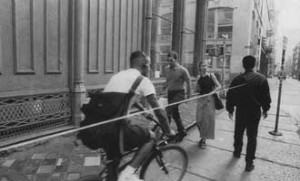
Translated Acts is the first large scale exhibition in New York of work by Asian artists since the landmark ‘Inside Out’ show in 1998 at the Asia Society and PS1. In contrast to the previous sprawling survey, this more concise exhibition focuses on performance and body art from Japan, Korea, Taiwan and China. In her catalogue essay, curator Yu Yeon Kim outlines two organizing principles, explaining first that East Asian artists have uniquely conveyed their historical and political positions through performance art, and second, that photography, video and other digital media and are no longer used solely as documentation, but are now integral to the artwork. By flagging this change, Kim herself documents the way in which the particular cultural and economic situations of Asian countries has resulted in an avant-garde art fundamentally different from the West.
While there is a slight bias towards male, Chinese artists, the nearly thirty featured artists are a diverse group that includes those living and working in their native countries as well as ex-pats from different generations. Young, international artists like the ubiquitous Mariko Mori and Michael Joo, whose sculpture was included in the 2000 Whitney Biennial appear alongside artists like Xu Bing, Zhang Huan and Gu Wenda. All of the above continue to receive significant attention in the US and provide some anchors to aid the New York audience in understanding this ambitious and intense exhibition.
Translated Acts does not propose to be a ‘who’s who’ of performance artists in Asia, nor is it a historical survey. Instead, the assembled group of work has similarities and differences that inspire reflection on the multitude of conceptual tactics employed by East Asian artists over the past decade. In her catalogue essay, Yu Yeon Kim warns her audience against interpreting the artwork solely in relation to the Western, modernist paradigm. To this end, she briefly outlines the tumultuous political and economic events of the last 50 years in each of the countries represented. She also develops an argument that Asian artists are likely to be influenced by Buddhist or Taoist ideology, which opposed to the hierarchies implicit in Western thought, accepts a more fluid concept of structure. Considering that at least a third of the artists in this exhibition live or were born in the West and taking into account the popularity of Eastern philosophies in the West in the past 50 years, this dichotomy may be less useful than Kim suggests. However, on a less philosophical level, many of the featured artists do acknowledge the importance of their faith in their work. Further, an approach which privileges the spiritual is an interesting counterpoint to the recent observations that China’s lack of “godly morality” has resulted in the use by some artists of the living or dead human body with little regard to its sanctity.
In keeping with Kim’s assertion that video and photography have become inseparable elements of performance art, the exhibition is stronger on performative photography and installation than actual performance. The promising but poorly organized opening events featured appearances by Chiharu Shiota, who slept in one of the many cot-like beds featured in her installation, Wang Jian Wei, who presented a red carpet resting on a bed of glass, which was methodically crushed by the visitors, as well as other performances by Ja-Young Ku and Chun-Chi Lin. A past performance by Chun-Chi Lin is presented on video, and documentation of Tehching Hsieh’s year long projects occupy one room. Hsieh’s performances, which double as feats of endurance, are meaningful in a Western performance tradition, but it is in the context of this exhibition alongside fellow Taiwanese that his radical experiments make fuller sense.
Fellow Taiwanese artist Chieh-Jen Chen’s recent large-scale photographs are the most disturbing pieces in the show, and likely contributed strongly to the Museum’s decision to restrict access for children. Suggesting the invasion of a devastating epidemic, or the impact of a tyrannical regime, the photographs feature scores of prostrate human bodies, covered with sores and invaded by metal clamps, harnesses and tubing. Also unnerving is Yuan Goang-Ming’s “The Reason for Insomnia”, an interactive sculpture in the form of a bed. When the bedposts are touched, different projections of blood, fire and feeling hands appear on the sheets.
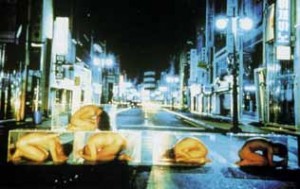
These dark images contrast sharply with Kim Atta’s ‘Museum Series,’ in which nude models hold prolonged poses in glass boxes placed in Buddhist temples and serene landscapes. These sublime bodies establish a recurrent theme of the idealized versus the absent, injured or defiled body. Contrasts appear throughout the exhibition, for example between Mariko Mori’s ‘alien body’, a perfect specimen enclosed in a pill-like capsule and deposited in various locations around the world, and the defiling rituals carried out by her countrywoman Chiharu Shiota.
Unclothed bodies result in the most striking imagery of Translated Acts. Collages and videos from Ma Liuming’s nude photo sessions with the public, during which he places his own unprotected body at the disposal of his audience, show the artist in a sometimes meditative, sometimes indifferent state. A public dynamic was also central in Zhang Huan’s ‘My America’, seen in Spring 2000 at Deitch Projects in Soho. This video, created from documentation of a performance in which a large group of Western volunteers shed their clothing and followed Zhang’s directions, is a portrait of the artist as he navigates a place for himself in his new country.
Other fruitful juxtapositions surface in the show’s installation. Gong Xin Wang’s ‘The Face’, his own laughing and eventually disappearing head, is positioned opposite Young Kyun Lim’s serene portraits of Korean youth. In another room, photos from Qui Zhijie’s ongoing Tattoo series, in which the artist continues a pattern from the wall behind him onto his own naked torso, appear next to documentation of the now legendary performance, ‘Cultural Animal,’ by Xu Bing, in which a mannequin and live pig were stamped in nonsensical Chinese and English script. Next to these two pieces is a video document of Gu Wenda’s ritual performances in which he writes calligraphy with an enormous brush. This combination of three uses of calligraphy by three Chinese artists who privilege the body is a mini-exhibition in itself.
Yu Yeon Kim’s triple concerns of ‘…cultural identity, historical legacy and inner expression…” cut across national borders in Asia, and apply to artists living at home and abroad. They also offer a way for Western viewers, unfamiliar with the unique and turbulent histories of East Asia over the past half-century, to engage the artwork. Kim has successfully brought together a mixed body of work that comments on the specific cultural backgrounds of the artists and the political situations in which they find themselves. She also addresses the need to develop an understanding of work that has been produced on the other side of the planet and outside of Western frameworks of thought, in an era of globalized culture. ‘Translated Acts’ challenges Western viewers to look beyond the easily digested and much imported anime inspired artwork seen so often in the US recently, and to instead grapple with East Asian art through the truly universal subject – the human body.
